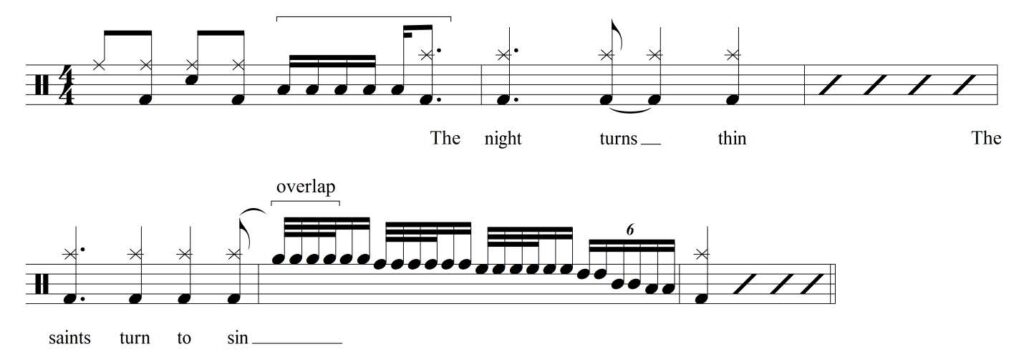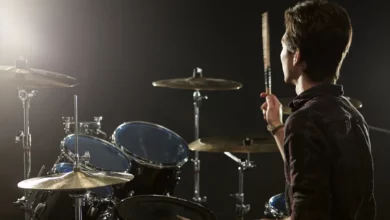
By Luis Ricardo Méndez
Neil Peart‘s recorded legacy with Rush is impressive and distinctive. Throughout his long career with the band, he came up with many great drum patterns and fills and some of the best-crafted lyrics in rock music. However, to the meticulous listener, the connection between drums and vocals that Peart achieved is equally remarkable.
This article will explore how “The Professor” employed his percussive abilities to highlight the lyrics’ message. This is also a personal attempt to explain why these unique drumming moments have always caught my ear since I first listened. All excerpts examined are taken from Rush studio recordings. You may need to listen to them several times, but make sure to listen to them in their entirety.
Let’s begin by looking at two of Peart’s classic fills, which he used as building blocks for some of the examples to be discussed. The fill shown below first appeared in the instrumental song “YYZ” from Rush’s Moving Pictures album, released in 1981. This fill is featured as a mini drum solo at around 1:50 of the song, adding a lot of excitement and motion to the music. We will refer to it as the YYZ fill.

The following fill was first recorded in the song “Cinderella Man”, from the album A Farewell to Kings, released in 1977. This fill is played there twice, at around 0:43 and then slightly varied at 2:13. Since it creates a sense of suspense and anticipation, we will call it the suspense fill.

Now, it’s time to move on and see the varied ways in which Peart related his drumming to the lyrics. Of course, all the vocals of the songs were impeccably delivered by the fantastic bassist/singer Geddy Lee.
1. Second Nature (Hold Your Fire, 1987)
This fill occurs at 2:58, in bar 12 of the second bridge of the song. It´s played as a percussive interjection between the lines “It’s hard to take the heat, it’s hard to lay blame” and “to fight the fire while we´re feeding the flames.”

Observe how Peart combined the YYZ fill and the suspense fill to create this memorable phrase. The particular makeup of this fill effectively leads the listener’s attention to the closing vocal line of the bridge, which makes the lyrics’ message have much more impact. An interesting exercise is to compare this fill to the one played at 1:35 in the first bridge. Mentally interchange both fills to notice the different effects each one generates.
2. Red Lenses (Grace Under Pressure, 1984)
The fill shown above is played at 3:55 in the ride-out section. This is a very intriguing fill. On the surface, it sounds like Peart had launched into the YYZ fill, but halfway through it, he changed his mind and decided to play a different one (see brackets in the example).

However, when considering the meaning of the surrounding lyrics, a surprising purpose is revealed – the fill mirrors the contrasting ideas expressed in the line “You see black and white, and I see red (not blue).” The unsettled nature of the first part of the fill matches the agitation expressed in the statement “I see red,” while the second part conveys the mood change implicit in the words “not blue.”
Also, notice how the whole fill is resolved on the second beat of the following bar, right where a ringing guitar chord is played.
3. Turn the Page (Hold Your Fire)

This fill happens at around 4:12 in the ride out of the song. Here, Peart employed the drums to reflect the meaning of the lyrics. Notice how he mimics the “future coming fast” by adding fast double bass flurries to the snare drum and china cymbal punctuations. Besides the word painting technique described above, the increased rhythmic motion also helps to raise the intensity level of the section.
4. Presto (Presto, 1989)
This fill occurs at 5:12 when Lee sings, “I’d set everybody free.” Peart claimed he didn’t play fills under a singing part in his A Work in Progress DVD. But as we can see, there were instances where he did so to achieve a specific purpose.

Peart played his fill along with the vocals to embody the yearning expressed in the lyrics. The accent pattern on the snare makes it feel like Lee is gathering energy to set everybody free, and then he magically sets them free when the fill goes down the toms. This is also an excellent example of tension and release, both musically and emotionally.
In addition, note how, in the three bars preceding the fill, Peart used his bass drum and crash cymbals to stress certain syllables of the vocals while playing the groove. He referred to this procedure as punching up the vocals.
5. Virtuality (Test for Echo, 1996)

The fill shown above is another fine example of word painting from the drums, which Peart pointed out in A Work in Progress when he talked about the drum parts he composed for the song. This fill occurs in the last chorus right after Lee sings, “send your impulse ´round the world,” where Peart sends that impulse around his world of drums.
6. Anagram (Presto)
This final example occurs at 3:25, right before the intro reprise at the end of the piece. Observe how the suspense fill effectively sets up the arrival of the section. Also, listen to how Peart and Lee stop playing the groove to punctuate the vocal line. This slowing down of the rhythmic motion makes the lyrics’ message stand out more.

The vocals and drums make an exciting closing statement at the end of the section. That effect is achieved through the rhythmic acceleration and the upward/downward melodic motion between the line “the saint turns to sin” and the drum fill. The overlapping point occurs on the word “sin,” where the pitch of the small tom that starts the fill matches the high note sung by Lee. On the other hand, the length of the fill makes the contradiction of the lyrics stay a little longer in the listener´s mind.
Maybe Peart himself didn´t think of some of the observations made here about his drum fills, but the relationship between drums and vocals in the music of Rush is undeniable. And as Peart once stated about his drum fills, “they probably roll out that way for a good reason.” In any case, we drummers can be inspired by his ideas to find our way of interacting with the lyrics and, ultimately, to make more meaningful contributions to the music we create.



